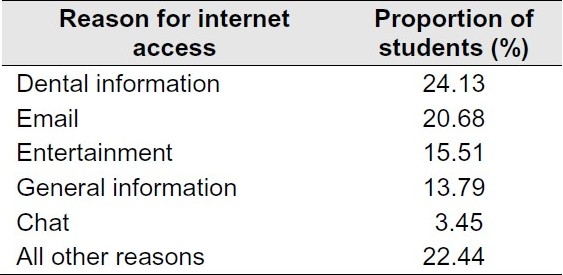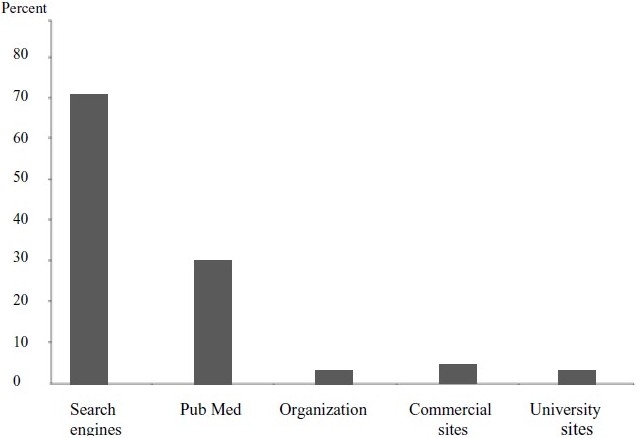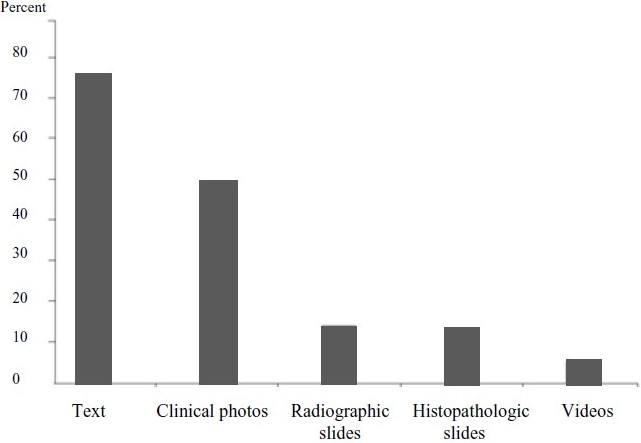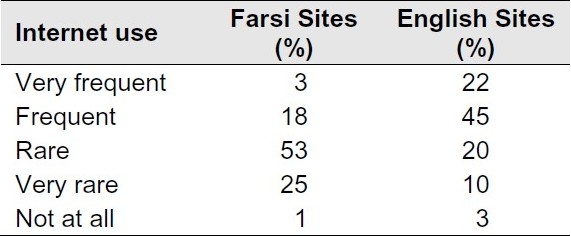Abstract
Background:
Internet is an important source of up-to-date dental information for delivering educational materials. The aim of this study was to determine the use of internet among dental students in Yazd.
Methods:
In this descriptive study, a questionnaire consisting of multiple choice questions was distri-buted to clinical undergraduate students studying at the School of Dentistry at the Shahid Sadoughi University of Yazd, Iran in 2009. The chi-square test was used to compare the frequency of internet use between the two genders. The level of statistical significance for all tests was set at 0.05.
Results:
Seventy-nine percent of the students used the internet in various frequencies. In general, female students used the internet more often than their male counterparts (P < 0.0001). Although 13.79 percent of students used the internet to retrieve general information, dental topics were searched in the internet more frequently. The texts were the most commonly accessed materials (73.9 percent). Clinical photographs were accessed by 47.9 percent and radiographic and histopathologic materials by 12.3 and 10.9 percent of the students, respectively. Our students stated that they could find required information on dental subjects in English sites (96.6 percent) much more frequently than in the Farsi sites (78 percent).
Conclusion:
The results of this study reflect the attitudes of dental students to internet use as a part of their education in Shahid Sadoughi University of Yazd.
Keywords: Dentistry, Education, Internet, Students
Introduction
Although internet is a growing resource worldwide, little is known about its use for the teaching of dentistry, and whether undergraduate students find it useful.1,2 There are numerous advantages of internet mediated education. The internet is a userfriendly communication medium that is costeffective and fast.3–5 The required information can be accessed from anywhere with an internet connection and with no time limitation. The information on the internet is usually up-to-date, which makes it a useful tool to follow recent developments. Internet sites containing clinical, histopathological, and radiographic data create an environment for students to study at their own pace.6 The internet provides means of accessing the expertise of specialist clinicians and academicians of all over the world. Students can have the opportunity to learn about different views on controversial topics, review extensive case reports, and gain knowledge of rare diseases.7 In addition, to serve as a learning tool, the internet may motivate students to undertake research and help them develop skills in collecting and analyzing data. Discussion groups via electronic mailing or chat rooms, videoconferencing, interactive learning environment by animation, and simulation methods are further advantages of the internet.8–10 Another important advantage of the internet is that students in developing countries can have the opportunity to access a large pool of data, which could help reduce the information gap resulting from the disadvantages of the education opportunities in these countries. The aim of this study was to investigate the extent to which students in Shahid Sadoughi University Dental School take advantage of the internet during their dental education and to assess their attitudes towards the internet in general.
Materials and Methods
A structured questionnaire was distributed to clinical undergraduate students studying at the School of Dentistry at the Shahid Sadoughi University of Yazd, Iran in 2009. A questionnaire consisting of multiple choice questions was prepared regarding the methods students prefer to access dental subjects, reasons for internet use, where they get access to the internet, factors restricting students from using the internet, frequency of internet use and how often they are able to find dental subjects in Farsi and English sites. The content validity of the questionnaire was obtained through the review of other questionnaires, and three experts reviewed the questionnaire to establish face validity. Forms were distributed to all students attending lectures before the lecture started and were collected immediately after the students finished filling them out, which took approximately ten minutes. Seventy-three students (thirty-six female and thirty-seven male) out of a total of 120 were included in this study. The aim of the study was explained in detail, and students were reminded not to write their names in the forms. They were also reminded that they could choose more than one option in some of the questions. The data were analyzed using SPSS version 15 for statistical package. The chisquare test was used to compare the frequency of internet use between the two genders. The level of statistical significance for all tests was set at 0.05.
Results
A total of 79.45 percent of the students who took part in this study used the internet with various frequencies while 20.55 percent stated they have never used the internet; 17.24 percent of the students used the internet every day, 32.76 percent two to three times a week, 22.41 percent once a week and 10.34 percent once a month and 17.24 once in a couple of months for general use. In general, female students used the internet more frequently than their male counterparts. While 94.44 percent of the female students used the internet at least once a week, this frequency was 64.86 percent for male students (P < 0.0001). In addition, the use of internet by senior students was found to be more common than their junior counterparts. For instance, 100 percent of the lastyear students as opposed to 68.42 percent of the third-year students used the internet.
Students accessed the internet most commonly at home (64.24 percent). While 55.17 percent preferred university and/or faculty computer facilities, 17.24 percent connected to the internet from internet cafes.
Table 1 shows the proportions of students regarding the reasons for internet access. Students used the internet most frequently for dental topics (24.13 percent). When analyzed according to gender, female students (96.3 percent) used the internet more than did male students (86.95 percent) to access dental information (P = 0.225). Similarly, although not statistically significant, male students preferred the internet to obtain general information more frequently than did female students.
Table 1.
Proportions of students regarding the reasons for internet access

Figure 1 shows the internet sites that students preferred to use to access information on dental topics. Students who used the internet most commonly preferred search engines by entering key words (73 percent). This was followed by use of Pub Med and University sites.
Figure 1.

Distribution of internet sites used by students to access dental subjects
Regarding the dental topics, texts were most commonly (73.9 percent) searched. While 47.9 percent of the students accessed clinical photographs, radiographic and histopathologic materials were favored by 12.3 and 10.9 percent, respectively (Figure 2).
Figure 2.

Distribution of sources on the internet preferred by students to gain information on dental subjects
The percentage of students regarding how frequently they accessed dental information in Farsilanguage and Englishlanguage sites is presented in Table 2.
Table 2.
Percentages of students regarding how frequently they accessed dental information in Farsilanguage and English-language sites

The main reason for not being able to use the internet was said to be lack of time. This was more obvious for the lastyear students. While 9.3 percent of the students complained that they had difficulty in finding a computer with internet access, 7 percent stated that the cost was the drawback for internet use. Fourteen percent of the students stated that they do not know how to use the internet, and in this regard male students outnumbered females.
Discussion
The internet and the most known part of it, the World Wide Web, are one of the greatest inventions of our time. The formation and the growth of the big Net have changed the way we do business, communicate, entertain, retrieve information, and even educate ourselves. This worldwide medium allows interaction with people regardless of geographic location and it is a great exchange and source of data, information and software. Internet use is becoming more and more commonplace in Iran. However, currently, utilization of web-based education in dentistry is in its infancy. A basic information technology course has been introduced in the undergraduate curriculum in Faculty of Dentistry, Shahid Sadoughi Medical University since 2001. However, the findings of this study suggest that an information technology course, in the absence of other amenities, is not enough to motivate our students to use the internet more often for their education.
The frequency of internet use is higher among Iranian students compared to some European counterparts. In this study, among students who used the internet, 72.41 percent accessed general information at least once a week and 82.75 percent at least once a month, as compared to 26 percent and 83 percent in Britain, respectively.11 This difference can be attributed to different years in which studies were done. Computer use for dental purposes appears higher among dental students in the United States. Schleyer et al.12 reported that 45 percent of the students from nine dental schools in the United States use the computer for schoolrelated purposes at least two hours per week. At present, there are only seven computers with internet connection allocated for undergraduate student use in the dental school library. Although there is an extensive central computer library in the university, it is not located in close proximity to the dental school. The limited access of the internet in the dental school may be the probable reason for why home is preferred most commonly for web searches. Likewise, 16.3 percent of the students stated that having difficulty to access the internet kept them from using the web. Betterequipped computer laboratories with continuous and free of charge access to the internet in the dental school would enable students to use it more frequently as part of their education. Electronic curriculum, consisting of computer-based learning including educational materials available on online courses, may encourage students to use the web for dental purposes and enhance dental education.13–15 The home page of our faculty does not serve the students for educational purposes, apart from electronic mechanisms to search the literature provided by the university. In Iran, some dental schools have home pages with dental materials together with useful internet links, but in general, electronic curriculum is a neglected issue mainly due to financial and technical difficulties.
Online learning is becoming a recognized method for delivering educational content throughout dental schools in Northern America.16–19 Interactive online learning through webbased courses should also be implemented in dental schools in Iran, which may transform education from lectureonly courses to student-driven learning.
Required information on the internet can be found by either entering key words in search engines (such as Google or Yahoo) or going to the URL of a wellknown website directly. Furthermore, it is possible to access the abstracts or full texts of the articles published in scientific journals through a system provided by the United States National Library of Medicine Public Medical Information Service ( www.nlm.nih.gov). Unfortunately, a very limited number of the undergraduate dental students at Shahid Sadoughi University benefit from this system, which is used commonly in academia worldwide. Virtanen and Nieminen15 reported that 80 percent of the dental students in Finland use Ovid Medline and the percentage of the students who employ Medline search increased as the students grew in seniority. Shahid Sadoughi University dental students do not tend to survey the literature in the first years; however, all of the final-year students stated that they used the Pub Med literature search site. The reason for this increase in the final year may be due to the need for back-ground literature for their graduation theses.
In this study, it is notable that female students tended to use the internet more commonly than did male students. Nevertheless, a study conducted in several countries in Europe reported that female undergraduate dental students use the internet less frequently than male students.20
The opportunity to gain access to many international internet sources adds to the importance of learning foreign languages. Despite differences in various countries, it was reported that only 5 percent of dental students in Denmark, Greece, Hungary, Britain, Ireland, Netherland, Norway, Spain, and Sweden cannot speak a foreign language.20 Paradoxically, our students stated that they could find required information on dental subjects in English sites much more frequently than in the Farsi sites. This further underlines the importance of being competent in the English language in order to pursue the information provided on a vast number of dental sites.
This study included undergraduate students in one dental school, and the number of subjects was limited. Furthermore, it is natural to have differences in the attitudes of dental students on internet use between those attending betterequipped dental schools and those attending dental schools with limited internet facilities. Although the results of this study reflect the attitudes of dental students to internet use as a part of their education, multicenter studies would give a more reliable picture about the use of the internet by dental students in Iran.
Conclusion
The results of this study reflect the attitudes of dental students to the internet use as a part of their education in Shahid Sadoughi University of Yazd. In general, female students used the internet more frequently than their male counterparts.
References
- 1.Hattab NM, Lahmiti S, Abdelaziz AB, Saidi H, Fikry T. Internet and medical student in Marrakech. Ann Afr Med. 2010;9(2):68–72. doi: 10.4103/1596-3519.64756. [DOI] [PubMed] [Google Scholar]
- 2.Schleyer TK, Forrest JL, Kenney R, Dodell DS, Dovgy NA. Is the Internet useful for clinical practice? J Am Dent Assoc. 1999;130(10):1501–11. doi: 10.14219/jada.archive.1999.0066. [DOI] [PubMed] [Google Scholar]
- 3.Stromso HI, Grottum P, Hofgaard LK. Changes in student approaches to learning with the introduction of computer-supported problem-based learning. Med Educ. 2004;38(4):390–8. doi: 10.1046/j.1365-2923.2004.01786.x. [DOI] [PubMed] [Google Scholar]
- 4.Nattestad A, Attstrom R, Mattheos N, Ramseier C, Canegallo L, Eaton K, et al. 4.1 Web-based interactive learning programmes. Eur J Dent Educ. 2002;6(Suppl 3):127–37. doi: 10.1034/j.1600-0579.6.s3.17.x. [DOI] [PubMed] [Google Scholar]
- 5.Fincham AG, Shuler CF. The changing face of dental education: the impact of PBL. J Dent Educ. 2001;65(5):406–21. [PubMed] [Google Scholar]
- 6.Mattheos N, Nattestad A, Schittek M, Attstrom R. A virtual classroom for undergraduate periodontology: a pilot study. Eur J Dent Educ. 2001;5(4):139–47. doi: 10.1034/j.1600-0579.2001.50401.x. [DOI] [PubMed] [Google Scholar]
- 7.Freeman H, Routen T, Patel D, Ryan S, Scott B. 1st ed. London: Routledge; 2000. The Virtual University: The Internet and Resource-Based Learning (The Open and Flexible Learning Series) pp. 156–69. [Google Scholar]
- 8.Eaton KA, Francis CA, Odell EW, Reynolds PA, Mason RD. Participating dentists' assessment of the pilot regional online videoconferencing in dentistry (PROVIDENT) project. Br Dent J. 2001;191(6):330–5. doi: 10.1038/sj.bdj.4801176. [DOI] [PubMed] [Google Scholar]
- 9.Odell EW, Francis CA, Eaton KA, Reynolds PA, Mason RD. A study of videoconferencing for post-graduate continuing education in dentistry in the UK-the teachers′ view. Eur J Dent Educ. 2001;5(3):113–9. doi: 10.1034/j.1600-0579.2001.050304.x. [DOI] [PubMed] [Google Scholar]
- 10.Eynon R, Perryer G, Walmsley AD. Dental under-graduate expectations and opinions of Web-based courseware to supplement traditional teaching methods. Eur J Dent Educ. 2003;7(3):103–10. doi: 10.1034/j.1600-0579.2003.00281.x. [DOI] [PubMed] [Google Scholar]
- 11.Walmsley AD, White DA, Eynon R, Somerfield L. The use of the Internet within a dental school. Eur J Dent Educ. 2003;7(1):27–33. doi: 10.1034/j.1600-0579.2003.00268.x. [DOI] [PubMed] [Google Scholar]
- 12.Schleyer TK, Torres-Urquidy H, Straja S. Validation of an instrument to measure dental students′ use of, knowledge about, and attitudes towards computers. J Dent Educ. 2001;65(9):883–91. [PubMed] [Google Scholar]
- 13.Grimes EB. Student perceptions of an online dental terminology course. J Dent Educ. 2002;66(1):100–7. [PubMed] [Google Scholar]
- 14.Odusanya OO, Bamgbala OA. Computing and information technology skills of final year medical and dental students at the College of Medicine University of Lagos. Niger Postgrad Med J. 2002;9(4):189–93. [PubMed] [Google Scholar]
- 15.Virtanen JI, Nieminen P. Information and communication technology among undergraduate dental students in Finland. Eur J Dent Educ. 2002;6(4):147–52. doi: 10.1034/j.1600-0579.2002.00251.x. [DOI] [PubMed] [Google Scholar]
- 16.Wrzosek M, Warner G, Donoff RB, Howell TH, Karimbux N. A survey of information technology management at U.S. dental schools. J Dent Educ. 2003;67(10):1095–106. [PubMed] [Google Scholar]
- 17.Ludlow JB, Platin E. A comparison of Web page and slide/tape for instruction in periapical and panoramic radiographic anatomy. J Dent Educ. 2000;64(4):269–75. [PubMed] [Google Scholar]
- 18.Boberick KG. Creating a web-enhanced interactive preclinic technique manual: case report and student response. J Dent Educ. 2004;68(12):1245–57. [PubMed] [Google Scholar]
- 19.Komolpis R, Johnson RA. Web-based orthodontic instruction and assessment. J Dent Educ. 2002;66(5):650–8. [PubMed] [Google Scholar]
- 20.Mattheos N, Nattestad A, Schittek M, Attstrom R. Computer literacy and attitudes among students in 16 European dental schools: current aspects, regional differences and future trends. Eur J Dent Educ. 2002;6(1):30–5. doi: 10.1046/j.1396-5883.2001.02373.x. [DOI] [PubMed] [Google Scholar]


